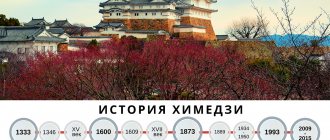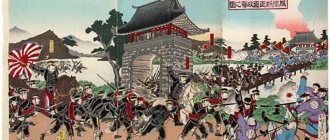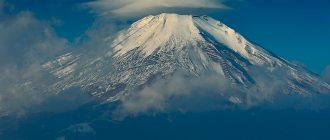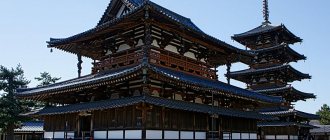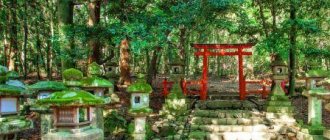Download the large encyclopedia of Japan from A to Z with multimedia:
NARA is the historical period of the existence of the ancient Japanese state from 710 to 794.
After the completion of the formation of a centralized state modeled on the Chinese one, begun by the Taika reforms (645), significant positive changes occurred in the economic sphere in ancient Japan. They were characterized, among other things, by a significant increase in the volume of surplus product and a rise in the standard of living. And although this period was relatively short-lived, it still stimulated the emergence of the first large cities, which had not existed in the country until then. In 708, a decision was made to build a new capital of the empire to replace the old capital, Fujiwara (kyo), which was poorly located, according to fortune tellers. In 710, the emperor moved into a new city, built taking into account the recommendations of Chinese geomancers and repeating the plan of the Chinese capital Chang'an, and his place of residence was named Heijo (kyo) - Capital of the Citadel of the World. The era during which the emperor's residence was in Heijo (kyo) is called Nara - after the name of the valley in which the new city was built.
The houses of the nobility and palaces were transported to the new capital in disassembled form, guards and administrative chiefs of all ranks, servants and artisans moved. Grandiose temple construction began immediately. Various crafts began to flourish, which caused an influx of population from villages and other provinces to the Nara region. The population of Heijo (kyo) during its heyday was 100–150 thousand people, which was quite a lot for Japan at that time.
The emergence of the first stable capital contributed to the strengthening of central government, improvement of the economic situation, as well as a number of administrative and political innovations that characterize that period. At the beginning of the Nara era, mass coinage began in Japan. Although this was rather a political step necessary to reinforce the authority of the state, where natural exchange had still dominated and taxes had not yet been universally replaced by taxes, it nevertheless brought the country to a qualitatively new economic level. To increase revenues to the treasury, several decrees were issued, mainly aimed at reorganizing agriculture and increasing the volume of taxable areas, including through the development of virgin lands, as well as encouraging the development of natural resources, mining ores and supporting the development of crafts. In land ownership at this time, this type of private estate became widespread, when the estate included outbuildings, warehouses and sometimes the headquarters of district commanders, as well as the virgin lands surrounding it. This type was called "early shoen".
The measures taken made it possible to somewhat modernize the country's economy, but they lagged significantly behind the political reforms carried out since the beginning of the 8th century. and broke the established old semi-slave system of social relations. This led to pronounced social instability and crises. In practice, this threatened the government with the growth of peasant unrest, increased resistance to the Ainu, the growth of banditry, etc. Various methods were proposed to combat these troubles, but in many ways they did not have the desired effect due to the incessant hostility between the court clans. During the Nara period, after a difficult struggle, the Fujiwara clan, whose most influential representative became Fujiwara Nakamaro, came to the fore in the emperor's entourage. This family managed to significantly influence the politics of the Japanese imperial court for about 200 years. The growing influence of the Fujiwara family coincided with the growing popularity of Buddhism, which after 741 actually became the state religion. Buddhist temples, now seen not only as sanctuaries but also as symbols of the philosophy of centralized government along the Chinese model, began to be built in every province, and in 743 construction began on a giant 16-meter statue of Buddha in the capital Todaiji Temple, ending in 752. In addition, Buddhist temples and monasteries received the highest permission to propagate their religion among common people, which made Buddhism a publicly accessible teaching of the entire people.
It is possible that the activity of Buddhist institutions was also associated with the revival of contacts with China that had been lost for a while. Japan's international activity also increased during the Nara period, although by this time China itself was already going through difficult times due to invasions by nomadic tribes, and the Japanese soon decided to transfer most of their contacts to the Buddhist states of Korea, primarily to the Bohai kingdom. The volume of trade with the Korean kingdoms was constantly increasing, and Japan even decided to abolish conscription in 792 and eliminate the coast guard in 795 due to the disappearance of the danger of military aggression from the Korean Peninsula.
The Nara period left a significant mark on the history of Japanese literature. In 712, the first known collection of historical records, the Kojiki, was compiled, and in 720, the Nihongi scrolls were written down, together officially setting out the history of the country, which became the basis for the attitude and education of the Japanese for hundreds of years. At the same time, a collection of poems by Japanese poets of that time was compiled - “Man'yoshu”, which is one of the most significant literary monuments in the history of Japan.
Formation of the Japanese state
The first mentions of ancient Japan are reflected in historical chronicles of the 1st century AD. Chinese Han Empire. The chronicles say that the ancient Japanese inhabited the islands in the East Sea, after which they established relations with China and sent it tribute.
Finished works on a similar topic
- Coursework The Nara period and the “rule of law” in Ancient Japan 470 rub.
- Abstract The Nara period and the “rule of law” in Ancient Japan 240 rub.
- Test work The Nara period and the “rule of law” in Ancient Japan 210 rub.
Receive completed work or specialist advice on your educational project Find out the cost
According to another source - the 3rd century compilation of the Chinese Wei Empire, which was called “The Legend of the Wa People”, there is a mention of 30 Japanese countries, among which Yamatai was the most powerful. It is said that the ruler of the country of Yamatai, a woman named Himiko, was in power for a long time, using “charms to stupefy people.”
In 710, the capital of Japan became the city of Heijo; China and its capital Chang'an also served as a model for its construction. 66 provinces were subordinate to the Heijo authorities, which in turn were further divided into counties and settlements. All provinces had connections with the capital through 7 tracks on which stations were located.
During the Nara period, the bureaucratic structure that is so hated by modern people fully took shape and flourished. Ministries appear, a large number of ranks and posts, which even in ancient times were obtained thanks to the influence of the family and its financial condition.
Capitals of Japan. Part 2. Heijo and the Nara period.
Sakura flowers are fragrant in Nara, the ancient capital.
And the palace courtyard was filled with the pure aroma of heaven. — Ise no Osuke
So, in the first part I kind of introduced everyone to the general historical course of things...
Let's start, probably, with Nara, as the first capital.
Nara, at that time called Heijo, represents incredible cultural value both for the Japanese and for any cultural tourists in general, because it is, one might say, an “ancient city”, like Kyoto.
This city officially became the capital in 710, and until that moment the state of Nippon...
Yes, by the way, if anyone is interested, until that moment Japan was called the state of Yamato (therefore, the period until the 8th century is called the Yamato period, and from 670 the country began to be called Nippon. The meaning of the word Yamato is not reliably known, it was originally written with the Chinese character “dwarf”, that is, “the country of dwarfs,” as the Chinese called the archipelago; but then the Japanese learned to read and write in Chinese, and they, apparently, felt very sorry for themselves, and they began to denote this word with the hieroglyphs “Great Harmony”...
The word Nippon (日本) reliably means “Source of the sun”, and even I, who am at a primitive level of knowledge of hieroglyphs, can say that “日” means “sun”, and “本” means “root”, that is, source, basis .
*Your cap x)))
Well, returning to the topic, it should be noted that until that moment Japan did not have a permanent capital, since after the death of each emperor they moved from place to place. This was related to their ideas of spiritual purity, and in their opinion, death (and, at least at the time of the Meiji birth, even the birth of a child) left behind spiritual "impurity." Although it should be noted that for the people of Yamato, even before that, the Nara region, or the then Asuka Valley, was the “capital region”, where all the palaces were located, from which they moved out and settled in new ones there. Therefore, the Yamato Period is divided into two periods, the last of which is the Asuka Period, immediately preceding the Nara Period.
And besides, the introduction of the Chinese state system, with its clear hierarchical structure, required a permanent, “settled” center that would both perform its functions and serve as a symbol for everyone of the institution of power itself.
Initially, the city was built according to the latest Chinese fashion - grid layout of streets, architecture and more... In fact, Heijo was a smaller copy of the capital of the Tang Empire, Changyang.
As you can see, the city and its districts consist of straight lines. In fact, the city was divided into eastern and western parts by Red Phoenix Street, the main street in the center that went to Heijo Palace. Along the edges of the two parts stood the Eastern and Western Temples. According to the ideas of the Sino-oriented architects of that time, such a layout ensured the correct circulation of energies.
But the city was incomparably smaller both in size and population (200 thousand people by the middle of the 8th century).
From 710 to 784 it was the vibrant political and cultural capital of Japan. This period is called the Nara Period. During these 74 years, the country was ruled by 8 emperors. Although, it must be said, the capital was moved to other cities twice: to Kuni-kyo (present-day Kamo, 740-745), Shigarakinomiya (present-day Shigaraki, and to Naniwa-kyo (present-day Osaka) .
This period was marked by the establishment of a rigid state system led by tenno (天皇 - heavenly ruler). But it was precisely this period that was marked by the beginning of a serious political struggle, accompanied by intrigues, murders and other dark affairs. The imperial family, fighting with itself for the throne, and fighting with the aristocrats trying to control it; the struggle of aristocratic clans with each other and with Buddhist monks for the right to have supremacy over other clans, and ultimately to establish control over the emperor; Buddhist monks trying to establish religious control over the state (one monk, Dokyo, even tried to change the ruling imperial family) ... Those times were turbulent, but compared to the upcoming political cataclysms, these were childish pranks. Ultimately, they defeated the Fujiwaras (I already wrote about this in a previous post), and established their control over the state, being regents under the emperors.
But in 784, Emperor Kammu, wanting to break free from the influence of the Buddhist religious elite, which, building one temple after another, surrounded the capital and stubbornly increased its influence, decided to move the capital to Nagaoka. However, due to delays in construction, civil strife and intrigue, and natural disasters, the idea was canceled and the capital was moved to the city of Heian (Kyoto).
So, this city is simply crammed with antiquities, such as Buddhist temples (by the way, the prefix -ji (寺) means a Buddhist temple):
-Todai-ji (東大寺 - Great Eastern Temple)
Kegon School Center.
This temple was built in 745 by local residents by order of Emperor Shomu. Then. In difficult times, when disasters and epidemics hit the country, the emperor ordered them to build a large statue of Buddha for patronage and protection. A huge number of people participated in the construction. Almost all the copper produced in the country was spent on the statue of Buddha. Finally, in 751, a 15-meter, 500-ton statue of Buddha Vairocana, which is considered the largest bronze statue in the world.
-Kofuku-ji ().
This temple was originally founded in Kyoto, but was moved to Nara in 710. It is the main temple of the Hosso-shu school (it takes a long time to explain, look it up on Wikipedia x)))
-Yakushi-ji (Yakushi is the Buddha of Medicine Yakushi Nyorai).
The temple is famous for its trinity of Yakushi: Yakushi Nyorai (by the way, some anime characters related to medicine are named after him, for example Kabuto Yakushi in Naruto and the Yakushi clan in Grandson of Nurarihyon) and the boddhisattvas Chandraprabhu and Suryaprabhu (and don’t ask what's happened). Also represents the traditions of the Hosshu school.
-Toshodai-ji.
Belongs to the Shingon school, although built in the Hosshu tradition. It was founded by the Chinese monk Ganjin, but was built after his death.
-Gango-ji.
Founded in the 6th century, the temple formerly belonged to the Soga clan. It was moved to the capital in 718.
-Saidai-ji (西大寺 - Great Western Temple).
The temple, founded in 765, is located in the opposite part of the city. As I already said, the layout in Nara was grid-like, that is, divided into squares and sectors, and often there were two buildings with a symbolic location in opposite parts of the city.
-Shin-Yakushi-ji (officially stated that Shin means “miraculous”)
Founded in 747 as Koyaku-ji by Empress Komyo.
-Dian-ji.
It was founded in 639 as Kudara Dai-ji, was moved and renamed Daikandai-ji, moved again to Nara in 716, and was finally rebuilt in Nara with its current name in 729.
-Enjo-ji.
Belongs to the Shingon school. It was founded in 759 by a Chinese monk who, together with Ganjin, came to Japan.
-Ryosen-ji.
It was built by order of Emperor Shomu in 739.
Phew...Give me a little break...
And so we came to the only (!) stronghold of Shintoism in the ancient capital - Kasuga-taisha. Nara was the capital of aristocrats, and the morals of aristocrats were ruled by Chinese fashion, and Shintoism was somewhere on the outskirts of this fashion, and was more widespread among the common people. But even among the aristocrats and emperors there were adherents of Shintoism, as evidenced by the construction of this shrine in 768. Initially, it was the Fujiwara Shrine. Yes, it is near this sanctuary that the legendary Deer Park is located.
Yes, by the way, deer are one of the symbols of this city. Deer are held in high esteem and favor here: they walk in regular parks and in parks near temples, and it is customary among tourists to feed them.
Why is there such a reverence for deer, you might say?
Deer here are considered messengers of the gods, kami. There are two main legends... So listen to two very short stories.
According to legend, when Heijo became the capital, the god Takemikazuchi-no-mikoto arrived in the new city under construction on a white deer to protect it.
According to another legend, the mythical (well, for us, skeptics, of course) first emperor Jimmu, the great-great-grandson of the sun goddess Amaterasu, descended from heaven to Nara on a white deer. (For some reason, one legend is circulating on the English wiki, and the other on the RuNet, so I am inclined to the first, since the Japanese study English more often than Russian x) Moreover, according to other legends, Jimmu arrived in Koshu and from there he already began expanding the island Honshu)
So...And it is believed that the deer in Nara are the descendants of that deer. As Shuleikin said in “Striped Flight”: “Believe it or not”...But I wrote it myself. So I put the copyright)
But wait, it’s too early to finish. I forgot about other places.
Nara, as befits a capital, has an Imperial Palace.
Heijo Palace cannot be called a successful example for other palaces. It was a palace only from 710 to 784, and after the transfer of power to Heian, it was simply abandoned. Time did not spare him, and the only ones who cared about him were the archaeologists who excavated him. And it has been slowly being restored since 1959, and many sections have already been completed.
In addition to palaces and temples, Nara has several old parks and gardens, such as Nara Park or Isuyen Garden, both dating back to the Meiji era (1867-1913). Nara Park (奈良公園 - Nara Kōen), founded in 1880. Territory - 500 hectares. As I said, there are a lot of deer there, and it is there, in the park or near and around the park, that Todai-ji, Kofuku-ji and Kasuga-taisha are located. So besides the official park area, there is a much larger area covered with one huge area of greenery, deer and traditional style wooden buildings.
In addition, there is the Nara National Museum, founded in 1889 as the Nara Imperial Museum. There you can learn more about the history of the city.
Here... They say that the city is full of an ancient atmosphere, and in Nara Park you can find real rickshaws near the temples. This is the ancient capital of Japan... In my opinion, although I have not been there, sorry)))
Nara was the capital for only 74 years and after that it was abandoned, and gradually fell into decay, and only with the advent of a new era for Japan, the authorities again paid attention to Nara, turning it and Kyoto into such museums of Old Japan, also attracting considerable income from millions of tourists (although most of them are their own).
So, I’ll tell you about Heian in the next post)


